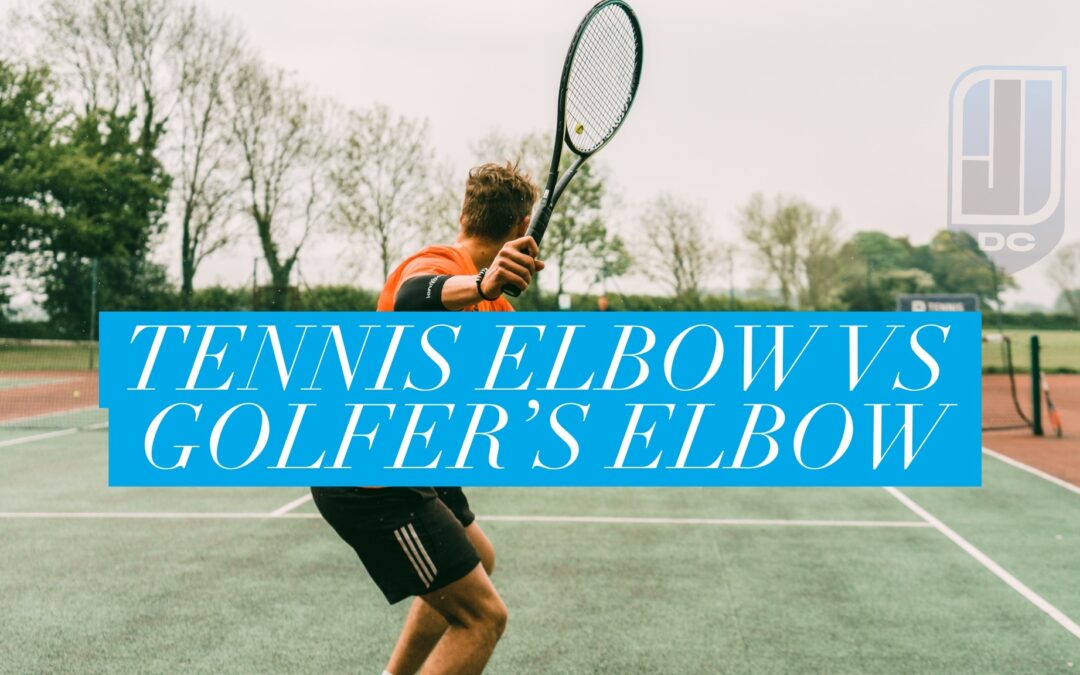If you’re trying to figure out what’s causing your elbow pain, you may be trying to figure out the differences between tennis elbow vs. golfer’s elbow. I’ll explain the differences between the two in this post.
Lateral epicondylitis is also known as tennis elbow and medial epicondylitis is also known as golfer’s elbow. These two conditions are the most common causes of muscle and tendon pain in the elbow. Typically, you’ll only have one of them, but sometimes you may struggle from both at the same time. Read on about how to easily tell if you have tennis elbow or golfer’s elbow.
Tennis Elbow Symptoms
Tennis elbow may cause the following symptoms in your elbow:
- Pain in the back and outside of your elbow (when your palm is facing forward with your arm at your side.)
- Elbow pain with activities like gripping and wrist extension (moving the wrist in the position you would to do a “stop” sign.
- Weaker grip strength when your elbow is straight.
- Lifting your middle finger is painful while your hand is palm down on a table.
- The outside and back of your elbow feels tight, ropey, and may be swollen.
Do You Have Other Questions About Tennis Elbow?
I have written a lot of content on tennis elbow. It’s all based on my experience treating many cases of it. Check out some of these other posts…
How Long Does it Take to Recover From Tennis Elbow?
The Best Treatment for Tennis Elbow Pain
Golfer’s Elbow Symptoms
Golfer’s elbow may cause the following symptoms in your elbow:
- Pain on the inside and front of your elbow and forearm (when your palm is facing forward with your arm at your side.)
- Shaking hands, opening jars, and gripping tightly causes pain on the inside of your elbow.
- Curling your wrist and squeezing increases pain on the inside of your elbow.
- The inside of your elbow feels tight, tender, and may be swollen.
The Main Difference Between Tennis Elbow and Golfer’s Elbow
The main difference between tennis elbow and golfer’s elbow is the location of pain. As you can tell, both conditions have similar symptoms. You can easily distinguish between the two conditions by following this rule:
Tennis elbow pain is in the outside and back of the elbow and forearm. Golfer’s elbow pain is on the inside and front of the elbow and forearm.
While this rule isn’t true in 100% of the cases, it is a reliable rule for the most part. It’s not 100% reliable because there are other conditions that can mimic both tennis elbow and golfer’s elbow. For example, many times radial tunnel syndrome can mimic or co-exist with tennis elbow. Cubital tunnel syndrome can mimic or co-exist with golfer’s elbow.
The Best Treatment for Tennis Elbow and Golfer’s Elbow
The best treatment for tennis elbow and golfer’s elbow is something called “conservative care.” Conservative care helps reduce pain, improve mobility, decrease tightness, strengthen weak muscles, and prevent the condition from returning. These are all things you want if you’re struggling with one of these conditions.
Where do you get conservative care for tennis elbow and/or golfer’s elbow? An experienced and rehab-focused chiropractor is a great choice for conservative care. A chiropractor can offer many helpful treatments for these conditions. As a chiropractor to treat tennis elbow or golfer’s elbow, I use treatments like:
- Mobilization and manipulation to restore normal movement to stiff and limited joints.
- Soft tissue massage to loosen up tight muscles and allow them to heal.
- Exercises to strengthen weak muscles and stretch tight muscles.
- Other modalities, for example ultrasound, to speed up the healing process.
Most cases of tennis elbow and golfer’s elbow resolve with these treatments and time. This is great news because it means most patients won’t go on to have injections or surgery.
If you have any other questions about tennis elbow vs. golfer’s elbow, then check out some of my other posts. Also, feel free to reach out and ask me any other questions and I’ll do my best to write a post to answer them.

Jason Williams DC is a licensed Doctor of Chiropractic with Physical Therapy Modality and Acupuncture privileges. He is a chiropractor in Dumfries, VA at Sentara Therapy Center. Dr. Williams’ clinical expertise is in the evaluation, treatment, and rehabilitation of neuro-musculoskeletal conditions. Specific focuses include spinal, extremity, and sports-related complaints. He brings a patient-first attitude to his treatments and is a proponent of evidence-based and integrative care. See more content and his contact info here.
The opinions and views are mine personally, and do not necessarily reflect the views of others in the profession, my employer, or organizations that I belong to.

